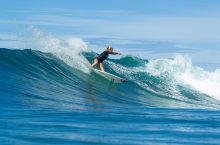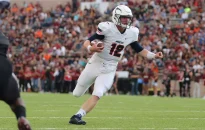A Trinity football player suffered heat stroke in July.Heat is one of the four leading causes of death in high school athletes.The KHSAA began a new requirement to measure heat in high school athletics in 2024.Just before 6:30 a.m. on July 31, during what’s referred to as the “dog days of summer,” WLKY meteorologist Susanne […]

A Trinity football player suffered heat stroke in July.Heat is one of the four leading causes of death in high school athletes.The KHSAA began a new requirement to measure heat in high school athletics in 2024.Just before 6:30 a.m. on July 31, during what’s referred to as the “dog days of summer,” WLKY meteorologist Susanne Horgan broadcast her weather headlines for the day.
Trinity’s president, Rob Mullen, told The Courier Journal in an email that Trinity’s cold tub is “located adjacent to the field in the sports training facility.” The school also has 10 AEDs, Mullen said, including one on the field at football practices and games.The U.S. military developed a heat condition scale based on five colored flags, with white being the lowest level when the wet bulb globe temperature is below 80, and black being the highest level, meaning all physical training and strenuous exercise is suspended.There are four leading causes of death in high school athletes, known as the four Hs: head (trauma), heart (sudden cardiac arrest), hemoglobin (blood) and heat.
Four hours later, at 10:20 a.m., a 911 call went out from Trinity High School’s football field. Junior offensive lineman Nathan Rader had collapsed on the home sideline.In April 2023, The Courier Journal published a four-part series, Safer Sidelines, that took an in-depth look at sudden death in youth sports and the gold standards of sports medicine that assure every athlete has a fighting chance when the worst happens.There are also four gold-standard tools for sidelines:
Stephanie Kuzydym is an enterprise and investigative sports reporter, with a focus on the health and safety of athletes. She can be reached at skuzydym@courier-journal.com. Follow her for updates at @stephkuzyAn online wet bulb calculator, which takes the wet bulb from nearby airports, shows that in Louisville on the day of Trinity’s practice, the heat would continue to rise, to the black-flag range, at 90.3 degrees, by 1 p.m.Reports show EMS arrived by 10:29 a.m.
Under the Kentucky High School Athletic Association’s 2024-25 schedule for football, athletes could practice in a helmet and shoulder pads through July 31. They could move to contact and full gear on Aug. 1.Portions of the 911 call were redacted for privacy reasons, but the dispatcher can be heard saying: “I understand.””They’re coming,” the caller can be heard shouting to others on scene. “C’mon, let’s go. … Right through here, onto the field.”
“Ma’am, you’re going to have to tell these people to come faster,” the caller says at nearly five minutes.”We need somebody here ASAP,” the caller said. “There’s a firehouse right down the street.”The last Louisville high school athlete to die of an exertional heat stroke was in August 2008. Pleasure Ridge Park sophomore Max Gilpin collapsed at practice on a 94-degree day while running sprints. He died after three days in the hospital. His parents sued football coach Jason Stinson. It was the first time in history a high school football coach was put on trial for a heat-related death of a player. His case was later expunged.EMS began an EKG, or electrocardiogram, of Rader’s heart at 10:35 a.m. and provided advanced life support. Within a minute, Rader was en route to the hospital in critical condition as a Level 1 emergency, based on EMS reports.Last season, the KHSAA began requiring schools to take the wet bulb globe temperature (WBGT) instead of the heat index. The WBGT gives a more accurate reading because the thermometer measures the conditions exactly where a team is practicing or competing. It also takes into account weather factors like sunshine, wind, humidity and radiant heat.
Safer Sidelines in Kentucky
The Courier Journal requested information regarding Trinity’s gold standard sports medicine tools. Under Kentucky law, because it is a private school, it is not required to provide the information.More:Sports safety: 10 questions to ask if you’re a parent of a youth athlete
In response to whether the cold tub or AED were used that day, Mullen said: “I cannot comment on the specifics of this incident. Thanks for understanding.”The caller said he was waiting for the ambulance, so he could direct it toward the football field, a protocol that follows Trinity’s venue-specific emergency action plan for Marshall Stadium, which the private school provided to The Courier Journal. (Since venue-specific EAPs are part of the Kentucky High School Athletic Association bylaws, as well as state law, both public and private schools are required to have them.)Reports from the day show the St. Matthews Fire & EMS unit dispatched within 32 seconds and en route within a minute and 36 seconds.The KHSAA’s WBGT practice policy states if the WBGT is below 86.9 degrees (a 95 degree-heat index), the WBGT should be rechecked every 30 minutes “if the temperature rises.”
“They’re coming as fast as they can,” the dispatcher said 2 1/2 minutes into the emergency call.
WBGT: new heat standard in Kentucky sports
St. Matthews Fire & EMS Station 46 is a half mile from the Louisville Catholic high school, but the medic unit, Medic 148, was dispatched from Station 48 in Lyndon, more than 3.5 miles from the field.”They’re going to have to do better,” the caller responded.”So, we’re going to be talking about hot weather, humid weather continuing for today, tomorrow and into Friday,” Horgan said.

At six minutes: “There’s nothing you can do?” the caller asked. “This kid’s out. You can’t tell these people to go faster?”The last death of a Kentucky high school football player happened in April 2023. Pulaski County’s Andrew Dodson’s head hit the turf during a spring scrimmage. He suffered a traumatic brain injury.
Mullen also said an athletic trainer did take the WBGT on July 31, and it rose from 69.8 degrees at the start to 84.5 degrees at the end of practice.The Courier Journal requested EMS and 911 reports through Kentucky’s open records law and received the last of those reports this month. They reveal the caller pleading with the 911 dispatcher to tell St. Matthews Fire & EMS to hurry for nearly nine minutes.Rader’s family said in a public Facebook post in mid-December that the boy was treated for heat stroke and spent almost two weeks in the hospital.
St. Henry District High junior Matthew Mangine Jr. was running the final sprint at soccer conditioning in June 2020 when he collapsed. 911 and EMS records revealed he didn’t receive a shock from an AED for at least 12 minutes. His family settled a wrongful death lawsuit for an undisclosed amount in January 2023 against the school, the Archdiocese of Covington and St. Elizabeth, the healthcare system that oversaw the school’s athletic trainers.














